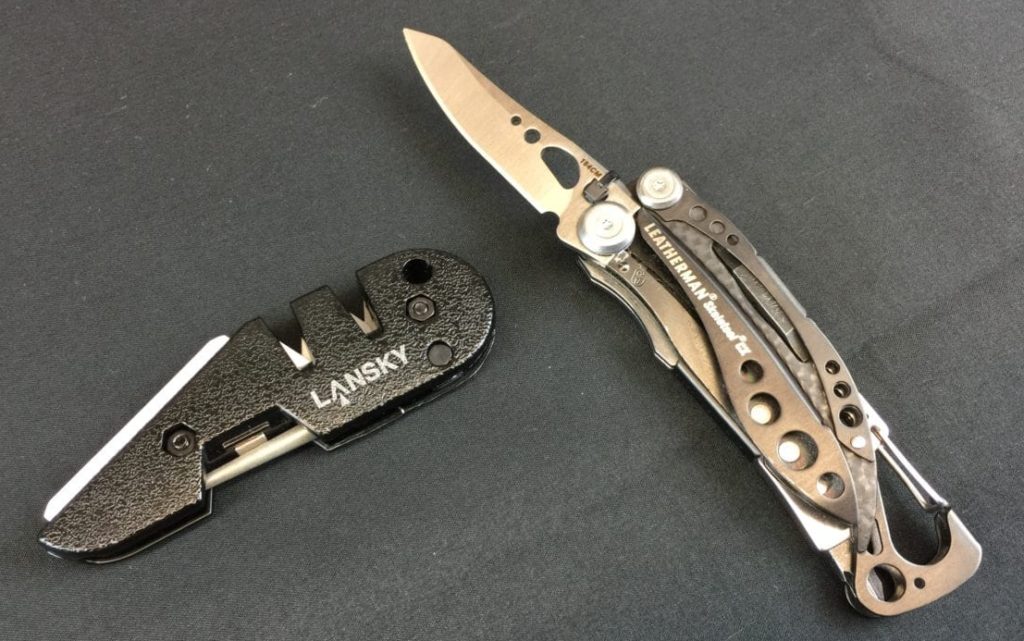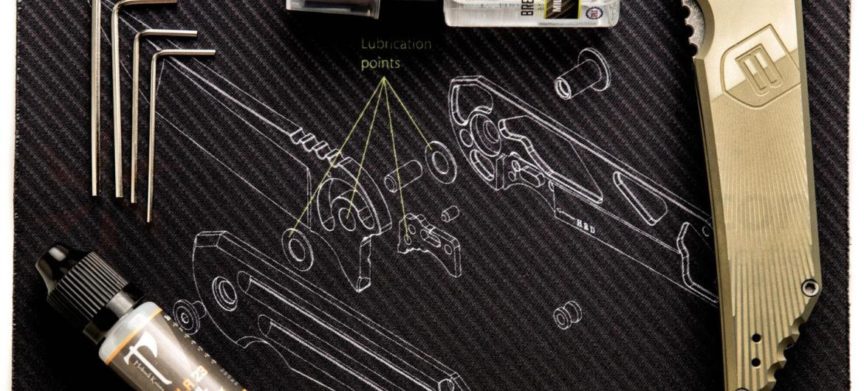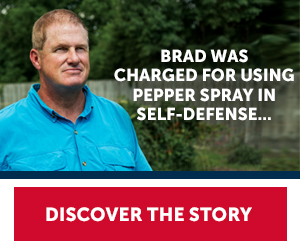The fact that you carry a multi-tool or knife shows that you want to be prepared to solve future problems when they arise. Part of being prepared is having the forethought to recognize future problems before you encounter them and then make the necessary changes or preparations to make solving those problems easier.
(This post may contain affiliate links (paid link). If you buy something through one of those links you will NOT pay more, but we may receive a small commission.)
When it comes to tools you count on, it’s important to keep them properly maintained and ready to use when you need them. This means keeping your multi-tool or knife in tip-top shape.
In This Article, We Are Going To Cover:
- Why It’s Important to Maintain Your Multi-Tool or Knife
- How to Safely Clean Your Multi-tool or Knife
- What Cleaners and Detergents are Ok to Use
- How to Protect Your Multi-Tool or Knife
- What Oils are Ok to Use
- When Extra Maintenance May Be Required
- How to Ready Your Multi-Tool or Knife for Long-Term Storage
Why You Should Keep Up On Maintenance
Most modern multi-tools and pocket knives are made from some form of stainless steel, but as some of you may know, stainless steel does not mean rust proof. So what does stainless steel mean?
The name stainless steel can be very misleading. Stainless steel is rust and corrosion resistant, not rust proof, but when compared to carbon steel, you would think it was.
How is stainless steel made? By adding Chromium to the steel it increases its corrosion resistance. But the more chromium in the steel the softer it becomes and the less chromium equals less corrosion resistance. This makes stainless steel less durable than carbon steel.
Finding a balance of carbon and chromium gives you a good compromise of strength, durability and corrosion resistance. But because the stainless steel used in tools and knives has a percentage carbon it can still rust.
When Is It Time To Clean Your Tool/Knife?
If you are anything like me, you take pride in your tools and for the most part, I’m quite diligent about daily and weekly cleanings, but not all people are as particular.
There are a number of factors that come into play that will affect how often you will need to perform general maintenance.
- How often do you carry it?
- When you do carry it, how often do you use it?
- How you carry it.
- What is the environment that you use it in?
I use the knife blade on my multi-tool nearly every day and after each use, I will generally wipe the blade off quickly and be done with it until I get home. After I am done for the day I will usually wipe the blade and any other tool I used that day, with a rag impregnated with my favorite oil.
If you carry your multi-tool or knife in your pocket then I have one simple thing you can do, to prevent lint buildup. I always use pocket clips, this alone saves a lot of grief. By using a pocket clip it keeps the most vulnerable part, the pivot mechanism, off of the bottom of your pocket where most pocket lint will collect.
How To Safely Clean Your Tool/Knife
Three Easy Steps
- Clean Your Tool
- Thoroughly Dry
- Protect Your Steel
Step 1: Get Your Clean On
First things first, if you carry your multi-tool or knife in your pocket every day but do not use it every day, you will most likely end up with some dust and lint packed in places you don’t want it.
Depending on usage and what multi-tools and/or knives I have in rotation, I will perform light cleaning weekly, sometimes monthly. But your mileage will vary.
A Light Cleaning
It’s best to start by blowing off any loose lint and dust. There are basically three ways to do this. The first and lowest tech way is to blow forcefully with your mouth. Although this method works in a pinch, it’s not ideal. Your second option is to use an aerosol keyboard duster or something similar. Lastly, the preferred method is to use compress air from an air compressor. This provides the best results.
Special Note: When using compress air from an air compressor make sure to carefully regulate the pressure, especially near
You want to make sure to blow off the outside and inside of the multi-tool. Open up all the blades and tools and blow out the channels where the tools are stored. Then make sure to blow between each tool at the pivot point. This is the most critical area to keep clean, as this is where you will have the most problems.
Now sometimes this is all you will have to do, but if you carry it a lot but don’t use your multi-tool or knife very often or if it has been a long time since it was last cleaned then a more thorough cleaning may be required.
Sometimes blowing it off with air just doesn’t do the trick but there is still some dust and dirt, but a full wash may not be necessary. At times like this, I will get out the Q-tips and some 3 in 1 CLP and scrub the pivot area and down the channels to remove the stubborn stuff.
A More Thorough Cleaning
When its time for a more thorough cleaning it’s time to get out the dish soap. Using a solution of warm clean water and a mild detergent soap like Dawn.
If I’ve gotten this far in the cleaning process I will go ahead and grab a toothbrush and start scrubbing, making sure to scrub between each tool, especially around the pivot and lock areas.
If you find tar, sap or other sticky and hard to remove stains on your steel, it is recommended to use a mineral spirit like turpentine to remove residue.
Special Note: If your multi-tool or knife is ever exposed to salt water it should be, at a minimum, rinsed with clean fresh water, dried, and thoroughly coated with a water displacing
Special Note: Most manufacturers of knives and multi-tools say not to use harsh chemicals or anything that contains chlorine to clean your knife or multi-tool.
Step 2: Thoroughly Dry
After a thorough wash you have removed all of the oil film that helps prevent rust and corrosion, so getting all of the water cleaned out and dried off is a must. First, go back to the compressed air again and blow off any excess water. Then flush out what’s left with a multi-purpose lubricant. Leatherman recommends CRC 3-36 (check it out here on Amazon) (paid link) but my favorite is a 3 in 1 called G96 Complete Treatment (click here to check it out on Amazon) (paid link) I use this stuff for everything from knives to squeaky door hinges. Not only does G96 work great it also has a pleasant smell that is not harsh like most CLP type lubricants.
Special Note: Many say to use WD-40 but Leatherman specifically says NOT to use WD-40 because it will corrode the type of washers they use.
Step 3: Protecting Your Steel
Now that you got your multi-tool or knife all squeaky clean it time to get a coat of protection on it. After flushing the water off with compressed air and G96 I let it soak in the G96 for a couple of minutes then wipe it down with a rag that is impregnated with G96. Doing it this way gives the G96 time to penetrate into the pores of the steel and leaves a light coat to prevent any rust from forming.
If you live in a coastal area or use your multi-tool or knife in adverse conditions, more frequent light cleaning and oil application will be necessary to protect the steel from rust.
Special Note: If you plan on using your knife blade for any food preparation it’s important to use only mineral oil or to thoroughly clean it with soap and water before using it on food.
Dealing with Rust
As we talked about earlier, stainless steel is not rust proof but rust-resistant, therefore without proper maintenance, it can and will rust. There are two different levels of rust. One being surface rust and the other being pitting or penetrating rust.
When dealing with rust, I prefer to use only the bare minimum of force necessary to achieve the desired results. Doing it in a progressive manner. Starting out mild with basic 3 in 1 CLP’s and moving on to more aggressive techniques only as necessary.
One thing to remember is that the more aggressive you have to be, to remove the rust the higher the chances that the Finish on the blade will be altered. This is more of an issue with blades that have a satin or bead blasted finish. But if it comes down to having it refinished to remove the rust then, you got to do, what you got to do. You have two choices, either remove the rust or don’t, but if you don’t it will continue to eat away at the steel.
Special Note: I don’t recommend that you disassemble your multi-tool or knife. Many manufactures state that disassembling their product will void the warranty. If your multi-tool or knife is so badly rusted that the manufacture won’t warranty it anyways then you got nothing to lose.
Rust Removal
I start by performing a full cleaning and inspection to see if there are any other affected areas. Then I start by soaking the affected area with a quality 3 in 1 CLP and let it sit for a couple of minutes.
It’s a good idea for the next step to have a good pair of gloves on. Then with a rag soaked with your favorite CLP, you rub carefully making sure not to cut yourself. If this doesn’t remove the rust then you will have to move on to more aggressive techniques.
For the next step, you will need some baking soda, a toothbrush and maybe a nonmetallic 3M Scotch-Brite scour pad. First, add the baking soda to warm water until you have a paste. Then apply to the affected area and scrub with the toothbrush.
If the rust is not gone after a bit of scrubbing you may have to move onto a Scotch-Brite pad. Care must be taken when using abrasive pads because you can affect the finish on the steel.
If you don’t like the idea of using an abrasive pad on your multi-tool or knife, another option is to use white vinegar. Just soak it in the vinegar for five minutes or less, then scrub with a toothbrush. Be sure to thoroughly rinse and oil well, vinegar is very acidic.
Sharpening Your Edge
Even the best knife blades need to be sharpened from time to time. I remember back when I was younger and collected knives we always used wet stones but the older I get the lazier I get or maybe it’s smarter because these days I use a v-block type sharpener.

My favorite knife sharpener these days is the Lansky BladeMedic. (click here to check it out on Amazon) (paid link) The BladeMedic is awesome it has four great tools, it’s small and easy to use.
- Tungsten Carbide V
- Ceramic V
- Serrated Knife Sharpener
- Diamond Tapered Rod
The Tungsten V makes quick work of dull and abused edges and the ceramic V is great for putting on that fine razor’s edge on.
Long Term Storage
There really isn’t much to prepare a multi-tool or knife for long-term storage. The main thing is to give it a good cleaning as we discussed previously. I would only do one thing differently. I would go heavy on the oil and not wipe off the excess.
Special Note: If your knife or multi-tool has a leather sheath do Not store it in the leather. Storing steel in leather cause rust to form.
Conclusion
Hopefully, by this point, your multi-tool or knife is rust free, clean and well protected. Just remember that; an ounce of prevention is worth a pound of cure. Taking just a few moments at the end of the day or week to give your tool a quick wipe down goes a long way in preserving its function and appearance.


